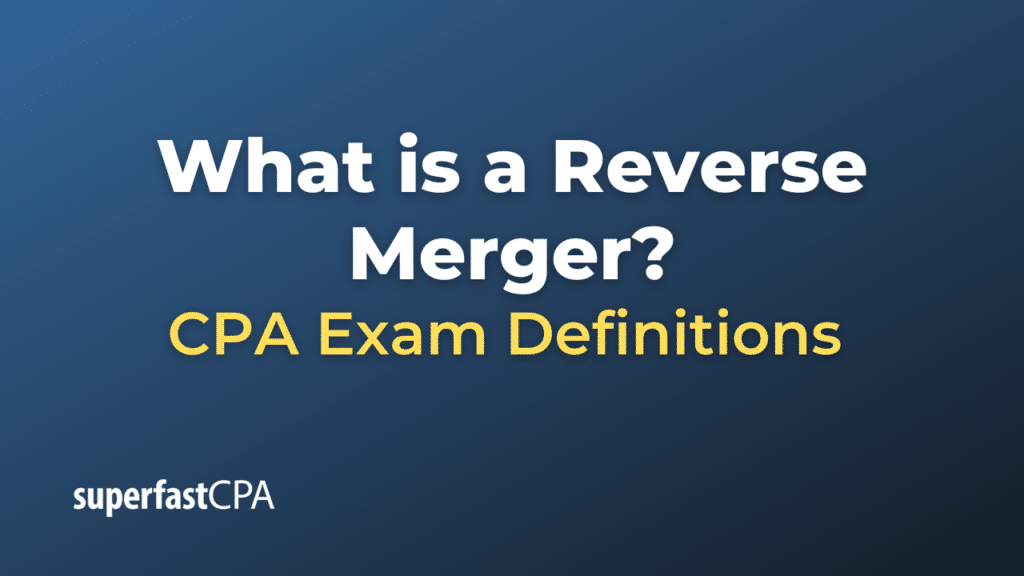Reverse Merger
A reverse merger is a process that allows a private company to become publicly traded without going through the traditional initial public offering (IPO) process. In a reverse merger, a private company merges with an existing publicly traded company that usually has no active business operations, often referred to as a “shell” company. Once the merger is complete, the private company effectively becomes publicly traded through the shell company’s existing stock listing.
Here is a step-by-step breakdown of the process:
- Identifying a Shell Company: The private company identifies a publicly traded shell company suitable for a merger. These shell companies often have no substantial assets or ongoing business activities but are still listed on a stock exchange.
- Agreement & Terms: The private company and the shell company negotiate and agree on the terms of the merger, including how the ownership of the new combined company will be divided among the shareholders.
- Merging the Companies : Upon reaching an agreement, the private company merges into the shell, with the private company’s shareholders often receiving a substantial majority of the shares in the new combined company.
- Trading: Post-merger, the once-private company is now part of the publicly traded entity and its shares can be traded on the stock exchange where the shell company was listed.
- Rebranding and Refocusing: Usually, after the reverse merger, the resulting public company changes its name to that of the private company, and the business operations of the private company become the main focus.
Advantages of a reverse merger:
- Faster and Potentially Less Costly: It can be a quicker and sometimes less expensive way for a company to go public than through the traditional IPO process.
- Less Regulatory Scrutiny: While there’s still significant oversight, the reverse merger process may be perceived as having less regulatory scrutiny compared to the traditional IPO route.
- Immediate Access to Capital Markets: Allows the private company to tap into the public markets for capital more swiftly.
Drawbacks of a reverse merger:
- Lingering Liabilities : The shell company might have undisclosed debts or liabilities that the private company becomes responsible for post-merger.
- Reputation Risks: Shell companies can sometimes have a checkered past, which might be associated with the new entity.
- Regulatory Risks: In some cases, regulatory bodies might increase scrutiny on companies that went public through reverse mergers, suspecting them of using the process to bypass the rigorous checks of the traditional IPO process.
- Market Perception: Investors and analysts might perceive reverse mergers as a less prestigious method of going public compared to the IPO route.
In conclusion, while reverse mergers offer an alternative path to becoming a publicly-traded company, they come with their own set of advantages and challenges. Companies considering this route should weigh these factors carefully.
Example of a Reverse Merger
One of the most notable examples of a reverse merger involves the electric car manufacturer, Tesla.
In 2004, Tesla Motors (as it was then called) executed a reverse merger with a shell company called AC Propulsion. AC Propulsion had developed an electric sports car prototype, but Tesla had its designs and ambitions. Instead of going through the lengthy IPO process, Tesla opted for a reverse merger with AC Propulsion.
After the merger, Tesla continued to develop and refine its own vehicles while utilizing some of the technology from AC Propulsion. This move allowed Tesla to become a publicly-traded company without an IPO.
However, it’s essential to note that Tesla’s rise to its current prominence involved many other significant events, including subsequent capital raises, strategic partnerships, and the scaling of its production capabilities. The reverse merger was just an early step in the company’s history.
Furthermore, in 2010, Tesla did hold a traditional IPO to raise more capital, but by then, the company had already been operating as a public entity due to the reverse merger.
This example underscores that while a reverse merger can provide a quick route to public trading status, companies often still need to engage in additional fundraising and strategic activities to achieve their long-term goals.













